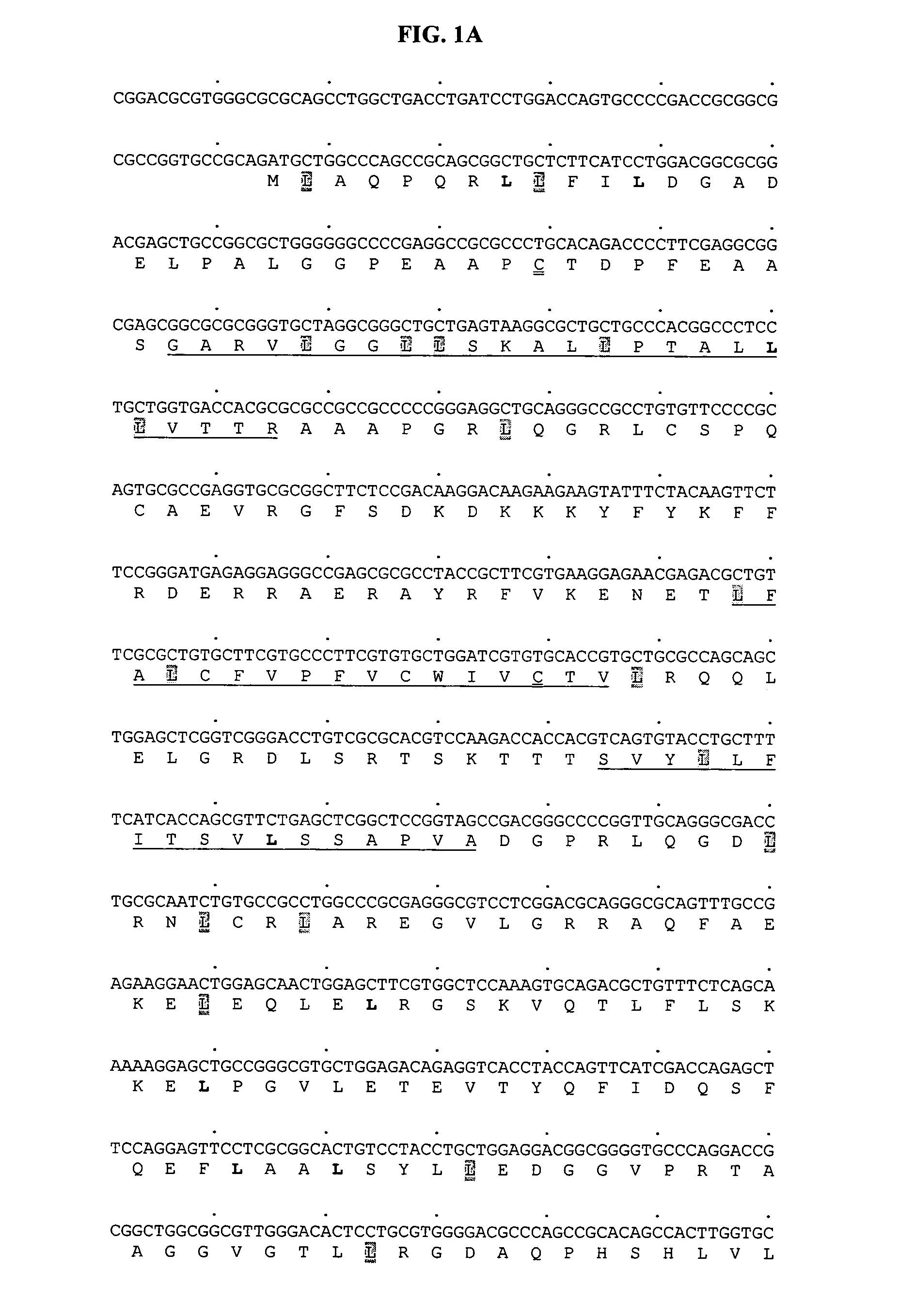Human leucine-rich repeat containing protein expressed predominately in small intestine, HLRRSI1
a technology of hlrrsi1 and human leucine, which is applied in the field of polynucleotides encoding hlrrsi1 polypeptides, can solve the problem that the apoptotic signaling in mammals is much more complex than in the human body
- Summary
- Abstract
- Description
- Claims
- Application Information
AI Technical Summary
Benefits of technology
Problems solved by technology
Method used
Image
Examples
example 1
Bioinformatics Analysis
[0762]A Leucine-rich repeat (LLR) domain containing protein, annotated as Angiotensin / Vasopressin receptor AII / AVP (Genbank Accession: AAC39910; SEQ ID NO:25) and other LLR-domain containing proteins such as KIAA0926 (Genbank Accession: NP—055737; SEQ ID NO:26) were used as probes to search the EST databases from Incyte and the public domain, in addition to the genomic database from the Human Genome Project. The search program used was BLAST (Basic Local Alignment Search Tool). From this analysis, ESTs and exons encoding potential novel candidates, related to Angiotensin / Vasopressin receptor, were identified based on sequence homology. The potential candidates (Incyte ESTs: 1632960H1 and Public domain EST GI number: g201045) were sequenced. Two clones were identified, entitled SILRR1A (SEQ ID NO:5; ATCC Deposit No. PTA-2679) and SILRR1B (SEQ ID NO:6; ATCC Deposit No. PTA-2674) was obtained using the EST sequence information. The sequence of these two clones wa...
example 2
Method for Constructing a Size Fractionated Brain and Testis Cdna Library
[0763]Brain and testis poly A+ RNA was purchased from Clontech and converted into double stranded cDNA using the SuperScript™ Plasmid System for cDNA Synthesis and Plasmid Cloning (Life Technologies) except that no radioisotope was incorporated in either of the cDNA synthesis steps and that the cDNA was fractionated by HPLC. This was accomplished on a TransGenomics HPLC system equipped with a size exclusion column (TosoHass) with dimensions of 7.8 mm×30 cm and a particle size of 10 μm. Tris buffered saline was used as the mobile phase, and the column was run at a flow rate of 0.5 mL / min. The resulting chromatograms were analyzed to determine which fractions should be pooled to obtain the largest cDNA's; generally fractions that eluted in the range of 12 to 15 minutes were pooled. The cDNA was precipitated prior to ligation into the Sal I / Not I sites in the pSport vector supplied with the kit. Using a combinatio...
example 3
Cloning of the Novel Human HLRRSI1 Polynucleotide
[0765]Using the following EST sequence, the following PCR primer pairs and antisense 80 bp 5′ biotinylated oligonucleotides (shown in Table III) were designed and obtained from Genset Oligos (San Diego, Calif.) for use in the cloning methods described below.
BMS Clone #12
INCYTE 1632960H1
EST Sequence:
[0766]
GCCACTTGGTGCTCACCACGCGCTTCCTCTTCGGACT(SEQ ID NO:7)GCTGAGCGCGGAGGGATGCGCGACATCGAGCGCCACTTCGGCTGCATGGTTTCAGAGCGTGTGAAGCAGGAGGCCCTGCGGTGGGTGCAGGGACAGGGACAGGGCTGCCCCGGAGTGGCACCAGAGGTGACCGAGGGGGCCAAAGGGCTCGAGGACACCGNNNNNNNNNNNNNNNNNNNNNNNNNNNNNNNNCCCAACTACCCACTGGAGTTGCTGTACTGCCTGTACGAGACGCAGGAGGACGCGTTTGTNCGCCAAAGCCCTGTGCCGGTTCCCG
[0767]
TABLE IIIOligonucleotides.OligoOligoOligonucleotideSEQ IDNo.NameSequenceLengthNO:363GPCR-12sCATGGTTTCAGAGCGTGTGAA2111364GPCR-12aTCGTACAGGCAGTACAGCAAC2312TC596GPCR-12CTTCACACGCTCTGAAACCAT8013GCAGCCGAAGTGGCGCTCGATGTCGCGCATCCCTCCGCGCTCAGCAGTCCGAAGAGGAA
[0768]One microliter (one hundred and fifty nanograms) of a ...
PUM
 Login to View More
Login to View More Abstract
Description
Claims
Application Information
 Login to View More
Login to View More - R&D
- Intellectual Property
- Life Sciences
- Materials
- Tech Scout
- Unparalleled Data Quality
- Higher Quality Content
- 60% Fewer Hallucinations
Browse by: Latest US Patents, China's latest patents, Technical Efficacy Thesaurus, Application Domain, Technology Topic, Popular Technical Reports.
© 2025 PatSnap. All rights reserved.Legal|Privacy policy|Modern Slavery Act Transparency Statement|Sitemap|About US| Contact US: help@patsnap.com



